Differential regulation of vascular tone and remodeling via stimulation of type 2 and type 6 adenylyl cyclases in the ductus arteriosus
- PMID: 20431059
- PMCID: PMC2892563
- DOI: 10.1161/CIRCRESAHA.109.214924
Differential regulation of vascular tone and remodeling via stimulation of type 2 and type 6 adenylyl cyclases in the ductus arteriosus
Abstract
Rationale: Prostaglandin (PG)E(2), which increases intracellular cAMP via activation of adenylyl cyclases (ACs), induces vasodilation and hyaluronan-mediated intimal thickening (IT) in the ductus arteriosus (DA) during late gestation. After birth, however, differential regulation of vasodilation and IT is preferable for treatment of patients with patent DA and DA-dependent congenital cardiac malformations.
Objective: Our objectives were to examine whether AC isoforms play differential roles in DA vasodilation and IT.
Methods and results: AC2 and AC6 were more highly expressed in rat DA than in the aorta during the perinatal period. AC6-targeted siRNA counteracted PGE(1)-induced hyaluronan production in rat DA smooth muscle cells. Overexpression of AC6 enhanced PGE(1)-induced hyaluronan production and induced IT in DA explants. Furthermore, IT of the DA was less marked in mice lacking AC6 than in wild-type and AC5-deficient mice. Stimulation of AC2 attenuated AC6-induced hyaluronan production via inhibition of the p38 mitogen-activated protein kinase pathway and AC6-induced IT of the DA. An AC2/6 activator, 6-[N-(2-isothiocyanatoethyl) aminocarbonyl] forskolin (FD1), did not induce hyaluronan-mediated IT in DA explants, although an AC5/6 activator, 6-[3-(dimethylamino)propionyl]-14,15-dihydroforskolin (FD6) did. Moreover, FD1 induced longer vasodilation of the DA than did PGE(1) without significant adverse effects in vivo.
Conclusions: AC6 is responsible for hyaluronan-mediated IT of the DA and AC2 inhibited AC6-induced hyaluronan production. Stimulation of both AC2 and AC6 by FD1 induced longer vasodilation without hyaluronan-mediated IT in the DA in vivo. FD1 may be a novel alternative therapy to currently available PGE therapy for patients with DA-dependent congenital heart disease.
Figures
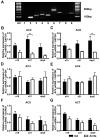
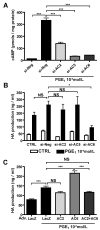

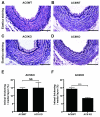
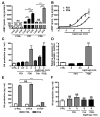
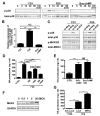


Similar articles
-
Regulation of vascular tone and remodeling of the ductus arteriosus.J Smooth Muscle Res. 2010;46(2):77-87. doi: 10.1540/jsmr.46.77. J Smooth Muscle Res. 2010. PMID: 20551589 Review.
-
Characterization of adenylyl cyclase isoforms in rat peripheral pulmonary arteries.Am J Physiol Lung Cell Mol Physiol. 2001 Jun;280(6):L1359-69. doi: 10.1152/ajplung.2001.280.6.L1359. Am J Physiol Lung Cell Mol Physiol. 2001. PMID: 11350817
-
Chronic activation of the prostaglandin receptor EP4 promotes hyaluronan-mediated neointimal formation in the ductus arteriosus.J Clin Invest. 2006 Nov;116(11):3026-34. doi: 10.1172/JCI28639. J Clin Invest. 2006. PMID: 17080198 Free PMC article.
-
Distinct characteristics of the basal activities of adenylyl cyclases 2 and 6.J Biol Chem. 1995 Sep 8;270(36):21368-73. doi: 10.1074/jbc.270.36.21368. J Biol Chem. 1995. PMID: 7673172
-
Prostaglandin E-mediated molecular mechanisms driving remodeling of the ductus arteriosus.Pediatr Int. 2015 Oct;57(5):820-7. doi: 10.1111/ped.12769. Pediatr Int. 2015. PMID: 26228894 Review.
Cited by
-
A novel role for PGE2-EP4 in the developmental programming of the mouse ductus arteriosus: consequences for vessel maturation and function.Am J Physiol Heart Circ Physiol. 2023 Oct 1;325(4):H687-H701. doi: 10.1152/ajpheart.00294.2023. Epub 2023 Aug 11. Am J Physiol Heart Circ Physiol. 2023. PMID: 37566109 Free PMC article.
-
Tissue-type plasminogen activator contributes to remodeling of the rat ductus arteriosus.PLoS One. 2018 Jan 5;13(1):e0190871. doi: 10.1371/journal.pone.0190871. eCollection 2018. PLoS One. 2018. PMID: 29304073 Free PMC article.
-
Adenylyl cyclase isoforms 5 and 6 in the cardiovascular system: complex regulation and divergent roles.Front Pharmacol. 2024 Apr 3;15:1370506. doi: 10.3389/fphar.2024.1370506. eCollection 2024. Front Pharmacol. 2024. PMID: 38633617 Free PMC article. Review.
-
Identification of differentially regulated genes in human patent ductus arteriosus.Exp Biol Med (Maywood). 2016 Dec;241(18):2112-2118. doi: 10.1177/1535370216661778. Epub 2016 Jul 28. Exp Biol Med (Maywood). 2016. PMID: 27465141 Free PMC article.
-
Molecular Mechanisms for Regulating Postnatal Ductus Arteriosus Closure.Int J Mol Sci. 2018 Jun 25;19(7):1861. doi: 10.3390/ijms19071861. Int J Mol Sci. 2018. PMID: 29941785 Free PMC article. Review.
References
-
- Smith GC. The pharmacology of the ductus arteriosus. Pharmacol Rev. 1998;50:35–58. - PubMed
-
- Waleh N, Kajino H, Marrache AM, Ginzinger D, Roman C, Seidner SR, Moss TJ, Fouron JC, Vazquez-Tello A, Chemtob S, Clyman RI. Prostaglandin E2--mediated relaxation of the ductus arteriosus: effects of gestational age on g protein-coupled receptor expression, signaling, and vasomotor control. Circulation. 2004;110:2326–2332. - PubMed
-
- Yokoyama U, Minamisawa S, Quan H, Ghatak S, Akaike T, Segi-Nishida E, Iwasaki S, Iwamoto M, Misra S, Tamura K, Hori H, Yokota S, Toole BP, Sugimoto Y, Ishikawa Y. Chronic activation of the prostaglandin receptor EP4 promotes hyaluronan-mediated neointimal formation in the ductus arteriosus. J Clin Invest. 2006;116:3026–3034. - PMC - PubMed
-
- Sunahara RK, Taussig R. Isoforms of mammalian adenylyl cyclase: multiplicities of signaling. Mol Interv. 2002;2:168–184. - PubMed
-
- Tang WJ, Gilman AG. Adenylyl cyclases. Cell. 1992;70:869–872. - PubMed
Publication types
MeSH terms
Substances
Grants and funding
LinkOut - more resources
Full Text Sources
Molecular Biology Databases

